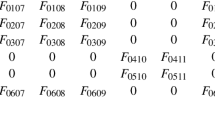Abstract
In a free material formulation, the problem of minimizing a weighted sum of compliance’s from multiple load cases, subject to an active constraint on material volume, is solved in a formulation with two optimality criteria. The first optimality criterion for the distribution of material volume densities is equal value for the weighted elastic energy densities, as a natural extension of the optimality criterion for a single load case. The second optimality criterion for the components of a constitutive matrix (of unit norm) is proportionality to corresponding weighted strain components with the same proportionality factor \(\widehat \lambda \) for all the components, as shortly specified by \(C_{i j k l} = \widehat \lambda \sum _{n} \eta _{n} (\epsilon _{i j})_{n} (\epsilon _{k l})_{n}\), in traditional notation (n indicate load case). These simple analytical results should be communicated, in spite of the practical objection against design for weighted sum of compliance’s, as compared to worst case design and design considering strength. The application of the approach of the two optimality criteria is illustrated by a 2D example with 8 load cases. Stable and fast convergence is shown.







Similar content being viewed by others
References
Bendsøe MP, Guedes JM, Haber RB, Pedersen P, Taylor JE (1994) An analytical model to predict optimal material properties in the context of optimal structural design. J Appl Mech 61:930–937
Bendsøe MP, Diaz AR, Lipton R, Taylor JE (1995) Optimal design of material properties and material distribution for multiple loading conditions. Int J Numer Meth Eng 38:1149– 1170
Czarnecki S, Lewinski T (2011) The stiffest designs of elastic plates: vector optimization for two loading conditions. Comput Methods Appl Mech Eng 200:1708–1728
Kocvara M, Stingl M, Zowe J (2008) Free material optimization recent progress. Optimization 57(1):79–100
Pedersen P, Pedersen NL (2013) On strength design using free material subjected to multiple load cases. Struct Multidisc Optim 47(1):7–17
Pedersen P (2003) A note on design of fiber-nets for maximum stiffness. J Elast 73:127–145
Stingl M, Kocvara M, Leugering G (2009) A sequential convex semidefinite programming algorithm with an application to multiple-load free material optimization.SIAM J Optim 20(1):130–155
Author information
Authors and Affiliations
Corresponding author
Rights and permissions
About this article
Cite this article
Pedersen, P., Pedersen, N.L. Optimality criteria for the components of anisotropic constitutive matrix. Struct Multidisc Optim 50, 181–191 (2014). https://doi.org/10.1007/s00158-014-1060-8
Received:
Revised:
Accepted:
Published:
Issue Date:
DOI: https://doi.org/10.1007/s00158-014-1060-8




